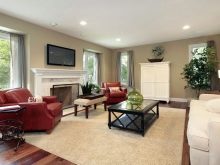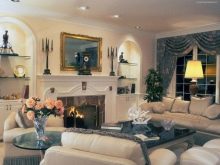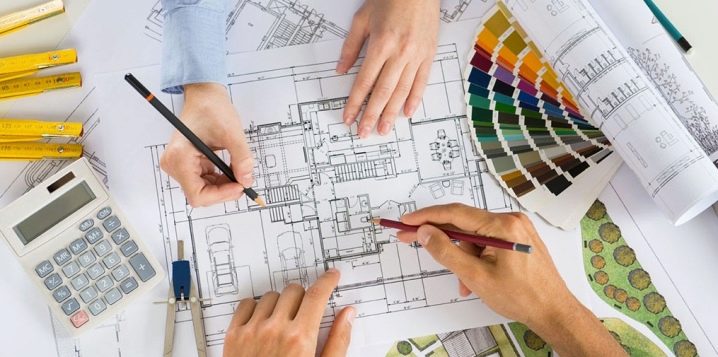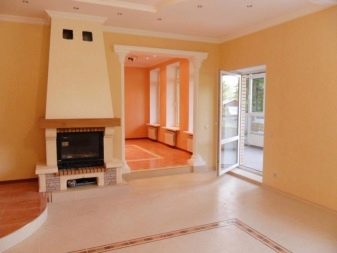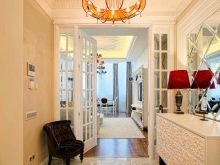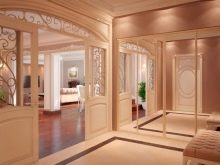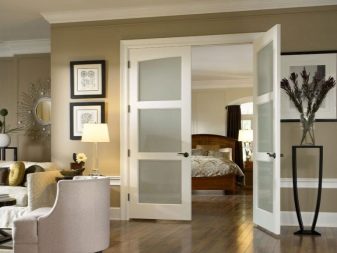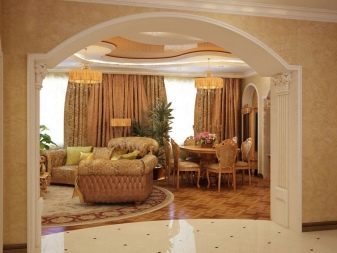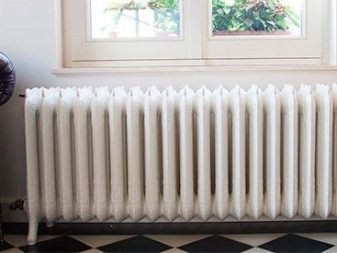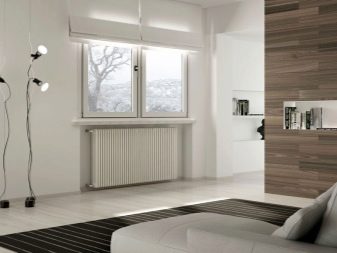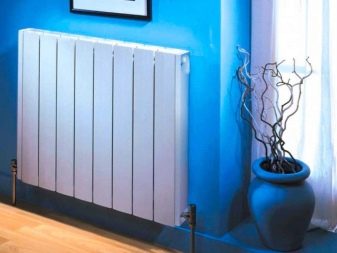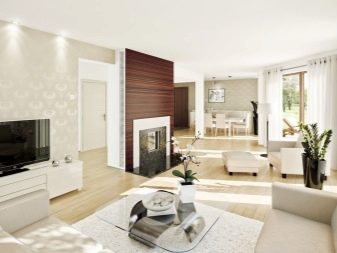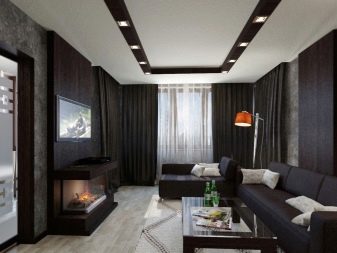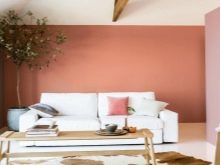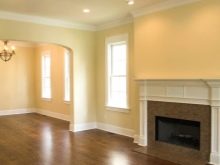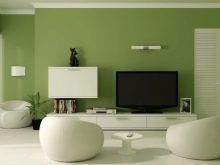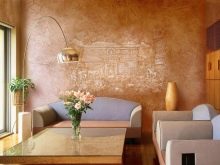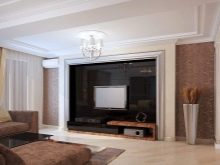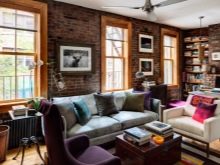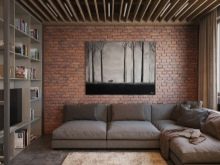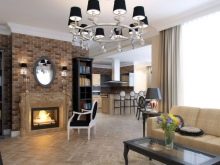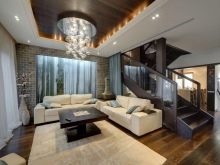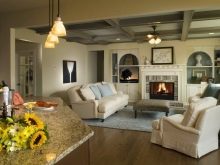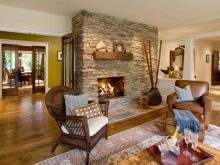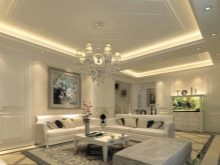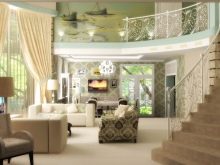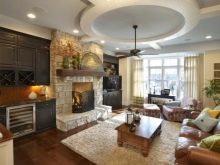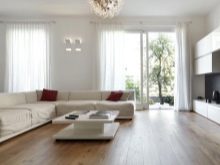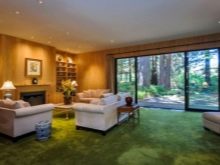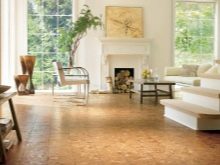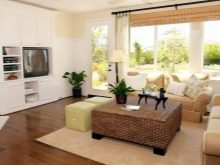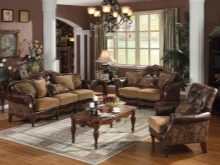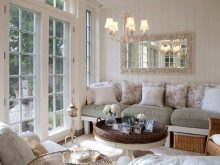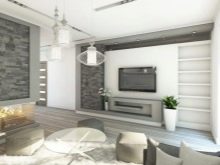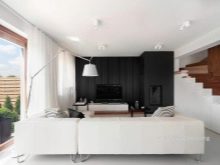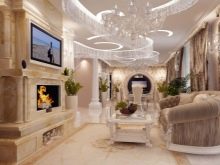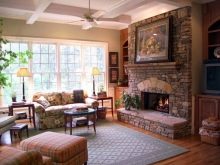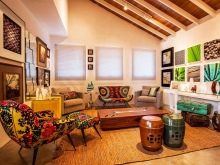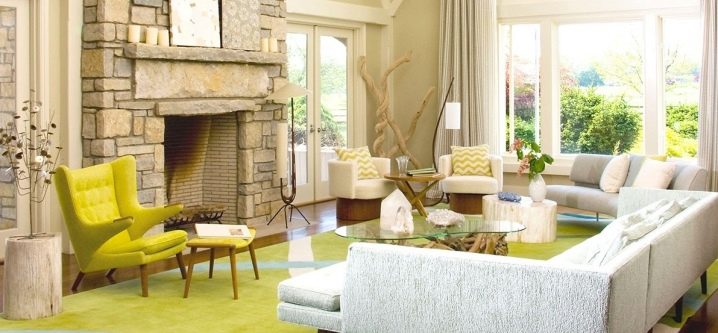Examples of repairing the living room in a private house
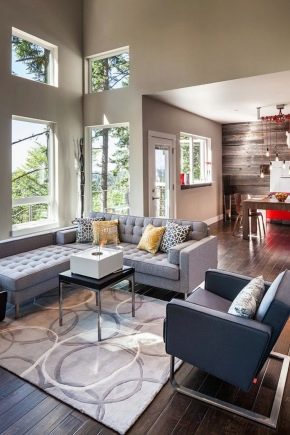
Living rooms in private homes are distinguished by a variety of sizes and shapes. Most often there are rooms with an area of about 20 squares. This territory is quite enough to embody any designer's intention. But there are also small rooms, or, on the contrary, large ones with a bay window or with two windows. In any case, the hall is the main room of the house, bearing a special aesthetic load, so the repair in it must be of high quality.
Preparatory work
It is necessary to begin repair with the sketch of the room and definition of its exact sizes. Then a design project is drawn up, which provides for every detail. It is necessary to choose the style of the future interior, to think about what the household in the renovated room will do. On this depends the zoning of the room.
It is necessary to determine in advance with the furniture, appliances and lighting devices. A clear idea of the future interior will allow to correctly place the wiring, sockets and switches, highlight zones, calculate the budget.
The room is free from furniture and appliances. It is necessary to determine in advance what the construction work will be. If only cosmetic, it is enough to get rid of old wallpaper and re-glue them on their own, and if there is a major renovation, you may have to invite specialists.
For serious repairs, they remove the old finish, dismantle the wiring, windows, doors. Sometimes in private houses from the living room there is a staircase to the living rooms of the second floor. If it requires replacement, the ladder must also be dismantled.
Windows, doors
When purchasing doors and double-glazed windows, you should have an idea about the style that will be in the end. Such styles as eco, Scandinavian, rustic, country, baroque and others that require finishing from natural materials will not suit plastic double-glazed windows. You can replace them with wood. To date, they are produced in good quality and varied colors.The same requirements apply to the door leaf.
Doors can be hinged, sliding, folding, wooden, plastic, MDF, combined, with a mirror or glass. They can be replaced by an arch.
Radiators
Batteries in the living room should not only give their heat to a large room as much as possible, but also have a presentable appearance.
They are of several types:
- Cast Iron Radiators - the usual classic type. They look cumbersome and not aesthetically pleasing, but otherwise, they do an excellent job with their duties, they have good heat transfer and a low price.
- Steel - simple, not expensive, but with low efficiency.
- Aluminum - with high heat transfer, but with them it is possible to use high-quality water, which is unacceptable in the conditions of an apartment. In a private house, you can adjust the heating system with purified water.
- Bimetallic batteries - just perfect: beautiful, elegant, light and effective.
Walls
Before you start decorative finishing work, you need to prepare walls well. First, they are leveled with starting putty, then finishing. If the walls are severely deformed, it is better to use drywall.With it, you can create niches, columns and other geometric designs to the delight of designers. Drywall is mounted on a metal frame, then covered with a finishing putty and decorative trim.
Prepared walls are covered with wallpaper, it is inexpensive and cozy. With the help of their image, you can “play” with the space: the horizontal pattern expands it, the vertical one pulls it out.
Light color visually increases the territory, the dark wall gives depth.
Walls are painted with water-based, acrylic or water-dispersion paints. This is the budget option of finishing work. It is not necessary to dye all surfaces in one color, you can play on the accent or contrast of shades.
Decorative plaster is in great demand. It hides the irregularities of the walls and has no restrictions in color. For families with young children there is a good opportunity to keep the walls - to arrange their panels to the level of reach of children's handles. This material is made of wood, plastic, cork, MDF, as well as laminate and glass.
In private houses, one of the walls of the hall can be cleared to the ground.The brickwork will be an excellent support for the loft style. The original finishing solution is a natural or artificial stone.
The only disadvantage of this type of finish is the high price.
Ceiling
In private homes, ceilings are usually high, and there is no need to hide real dimensions behind glossy or mirror surfaces. For stretch ceiling, you can choose a matte finish. With the help of drywall get curly and multi-level design, they are well combined with the elements of the stretch fabric. The easiest and cheapest design option is wallpaper, they are selected to match the walls. Among the shortcomings of this material can be noted instability to moisture. Looks good and just painted ceiling.
Lighting
In our time, it is difficult to do with just one chandelier to illuminate the room. A large room, divided into sections, requires a zonal illumination. It can be small additional chandeliers, spotlights, floor lamps, table lamp.
Beautifully illuminates the room LED strip, hidden in the ceiling frame. With its help, you can also select pictures, a mirror or shelves with collections.All this abundance of light is controlled by the console, changing the color gamut, brightness, switching different zones in stages.
Floor
The hall is the most visited place in the house, so the flooring should be taken seriously.
The abundance of material in the construction market allows you to choose the flooring for any interior and wallet:
- Laminate - the most popular finishing material, it perfectly imitates different types of wood, is easy to assemble and quite durable in operation. It should not be laid in rooms with high humidity, but the living room is not one of those. Under the laminate need to make a flat screed and lay the substrate.
- Parquet It is a material of various types of wood. It is eco-friendly and looks great, but requires special care in operation and careful maintenance.
- Carpet used in cold rooms, it is soft to the touch, pleasant-looking. The disadvantage is complex care.
- Linoleum - for inexpensive repairs. This is a kind of classic of the genre, it is simple in styling, moisture-proof and easy to clean.
- Cork refers to natural materials, it is pleasant to the touch, it is laid in children's rooms.In the care of him should not use aggressive chemistry.
- Self-leveling floors - modern beautiful seamless coating. Of particular surprise is the floor with a three-dimensional pattern printed on it. Laying the self-leveling surface is quite complicated, it is better to entrust it to specialists.
Interior
When the repair is finished, the most pleasant moment comes - filling the space with comfortable furniture, decorating windows, placing lighting fixtures and pleasant trifles.
Being engaged in the interior, you should pay attention to the configuration of your living room. In a rectangular room furniture is placed along the walls. In a square room, you can use the center for arranging any area. Most often there is a seating area with soft furniture and a small elegant table.
Cabinets, cupboards, racks, cabinets, shelves should look like the style dictates. Sometimes you need hidden furniture with imitation of free walls, or, on the contrary, elaborate, complicated.
In a small room, light furniture will visually create space, but at the same time it should not be much. Against the background of light walls dark furniture looks good.
Style
The choice of style is a crucial stage in the formation of the interior, it must coincide with the aesthetic needs of the people living in it, otherwise it will be uncomfortable to be in the living room. Style is determined before the start of repair work.
- Classical design is time-tested, so never bother. He does not suggest anything unexpected or screaming. Solid furniture, natural wood in the finishing material, thick soft curtains, a lot of expensive little things, stucco - all this has a taste and a special chic.
- Provence Came to us from the south of France. The interior in this style is very nice, filled with pleasant baubles, tablecloths, curtains, ruffles, vases of flowers. At the same time, it is natural and simple, synthetic materials in its component are unacceptable.
- The exact opposite of Provence - youth hi-tech style. The main elements are metal and glass, no decor, just cold simplicity.
- Minimalism speaks for itself - too little of everything. This is a laconic style with a small amount of furniture, with the simplicity brought to the point of absurdity.
- Loft He came to us from the West, when in the days of the Great Depression, housing was given to factory premises.This style is represented by rough furniture, a wall with an open brickwork, use of lattices in an interior.
- Style fusion loves glass in any form.
- Baroque - screaming splendor, bordering on petty bourgeoisness. It is appropriate antiques, antique furniture, crystal and a lot of gold.
- Country music - rustic style, prefers natural materials, fine cell textiles, light furniture, simple decorations.
- Ethnic style they bind to the traditions of a particular country, for example, Japan or France, and try to conform to them. This interior is to taste of travel lovers.
Choosing a style for the living room, it is not necessary to follow its full performance, it is better to dry out to your tastes and feelings. In any interior do not recommend the participation of more than three colors. Congestion of furniture and oversaturation with trifles looks bad.
Any style in the living room of a private house will be good if you put a piece of yourself in it and make repairs yourself.
Review repair living room in a private house, see the video below.
